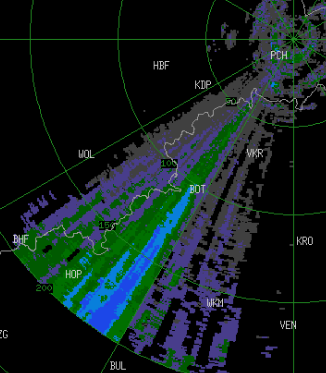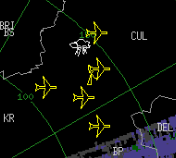Disclaimer
The NWU Lekwena radar is a test bed for students to learn and develop creative solutions related to weather forecasting and now-casting. This means that the Radar can be switched off for maintenance or it could be broken on purpose in the name of learning. The radar should not be used as a tool to make any severe weather alerts as the South-African Weather Service is the only credible institution to do this. The radar should only be viewed as a tool for the development of young scientists and something interesting to look at.
To view the live NWU Lekwena Radar image click here or scroll to the bottom of the page
How to interpret the radar image
Time
The radar is set to Coordinated Universal Time (UTC) and not South African Standard Time (SAST). To correct for this you need to add two hours to the time as indicated below, for example 12:04 UTC + 2 Hours = 14:04 SAST. To check if the radar is currently running the time should match within +-10 minutes of the actual time, if it doesn’t it’s safe to assume the radar or webserver is down.

Reflectivity (dBZ)
In the most basic terms a radar’s operation consists of a high frequency signal pulse that’s generated from the site, this signal echo’s when it interacts with large particles such as hail or raindrops and a receiver converts the echo into something human interpretable. This echo is represented as decibel relative to Z or dBZ. Strong dBZ means there are large particles producing a strong echo, this would be large rain, hail or ice particles in clouds.

Interference
The NWU Lekwena Radar has an license to operate on the 5.62 gHz bandwidth and any WiFi or communication network between 5.55 to 5.67 gHz causes problems and hampers data quality. The public is encouraged not to use these bandwidths in the Potchefstroom area and the NWU-CRG is willing to help users mitigate interference by advising on the installation of Dynamic Frequency Selection (DFS) devices. Users can also contact their service providers to learn more about the frequency of their devices and how to avoid interference with the Radar.

Places Indicators
The radar indicates towns with abbreviations and also some regional airports in the Gauteng Area with the Airplane sign. The little cloud sign indicates the location of the SAWS Irene Weather station. The circular lines indicate the distance of from the radar site, which is a maximum of 200km due to various factors such as the curvature of the earth

Real-Time NWU-Lekwena Radar

Background
Weather and climate impact every aspect of society. From annoying us on the road, to loss of life and damage to property. Weather radar is the quintessential tool for observing thunderstorms in real-time and using this information to manage and mitigate the impact of this phenomenon. South Africa has a long history in radar science and currently boast a world-class national network of cutting edge radars operated by the South African Weather Service (SAWS) which forms an integral part of the country’s national infrastructure.
Aims
This project aims to support SAWS and the national government towards sustaining and making the most of this valuable resource. We hope to do this by giving students from multiple disciplines hands-on experience working with this technology, creating awareness around the benefits and potential use of weather radar, and lastly to do applied research that could help create products and services that can be rolled out on the national radar network.
Partners
The North-West University, and the Water Research Commission has funded the acquisition, installation and upgrade of a weather radar, situated just outside Potchefstroom. The Lekwena Wildlife Estate provided the site, along with access control and security, and Aon-Benfeld funded the communication link to facilitate real-time access to the radar.
Further Reading
Everything You Ever Wanted to Know about the NWS WSR-88D
Radar Basics for the Non-Meteorologist
Media coverage
Media coverage of the NWU-Lekwena Radar
John Deere Promotional Video
Radar Launch Video
eNCA Segments
Department of Environmental Affairs Press Release
The Minister of Environmental Affairs, Dr Edna Molewa, has officially launched a state-of-the-art North West University (NWU) Lekwena Weather Radar, a weather radar network that provides a high-end scientific tool to study and quantify storms and precipitation. The launch took place in Potchefstroom today, Thursday 22 March 2018, a day before the international community commemorates the World Meteorological Day, marked annually on 23 March. This yearΓÇÖs theme is ΓÇ£weather-ready, climate-smart.ΓÇ¥
North West University Press Release
The NWU Lekwena Weather Radar is the result of a three-year study commissioned by the Water Research Commission, to develop a rainfall estimation algorithm, using rainfall data from the new dual polarized Doppler radar, and validate it against a dense rain gauge network.
SABC News: North West University to revamp old weather radars
Minister for Environmental Affairs, Edna Molewa, has welcomed innovation by the Climatology Research Unit of the North West University on revamping old weather radar built around the 1970ΓÇÖs into 1980ΓÇÖs.
Traveler24.com News Article
Cape Town - South Africa’s meteorological science field got a big new shiny weather radar on Thursday which can study and quantify storms and precipitation.
North West University’s (NWU) Lekwena Weather Radar was launched by Environmental Affairs Minister Edna Molewa and the SA Weather Service in Potchefstroom, just in time for the World Meteorological Day on 23 March